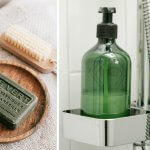
I was raised in the UK way back when a daily wash at the sink fulfilled all our personal hygiene needs. For this, the humble washcloth (or “flannel,” as we call it) was nonnegotiable. It was used to wet the skin before applying soap and to rinse it away again.
But when showering gained popularity in the 1980s, many of us abandoned the washcloth and used our hands instead. And in case we felt the need for a rubdown, we had body scrubs, which were a fun new thing. Actually, these trace back to ancient Egypt, but they were new to us.
I never considered the fact that a washcloth did the exact same thing—slough off dead skin cells. But even if I had, it was old hat as far as I was concerned.
The Washcloth Revisited
Then, a few months ago, I watched a dermatologist on YouTube remove facial cleanser with a washcloth. Being the type who can’t rinse his face with his hands without getting water all over the bathroom floor, this seemed a fantastic idea.
It was for this reason that I’d mostly skipped washing my face before bed. Now things were going to change.
The following day, I went out and bought 10 washcloths: one for each day of the week plus a couple of spares. That there are several materials available to match various needs and body regions didn’t occur to me at the time.
Materials
Cotton Terry Cloth
Cotton is the most obvious material, but not the softest. It’s most suited for washing and exfoliating the body and scalp (in case you’re bald) rather than the face and neck.
To avoid disrupting the skin’s natural barrier, which can cause dryness and inflammation, don’t use daily.
Microfiber
Microfiber offers several advantages.
Because it’s highly absorbent, it can pick up particles and remove excess oil with or without a cleansing agent. This is ideal for men with sensitive skin. Plus, it’s soft enough for the face and neck.
Furthermore, microfiber is quick-drying, meaning you won’t have to wait long before throwing it in the hamper. It’s also less likely to gather allergens and bacteria.
The only disadvantage is that it doesn’t last as long as other materials—a year at the most with proper care. When your microfiber washcloth begins to lose softness and absorbency, it’s time to bin it.
Muslin and Bamboo
Cotton muslin and viscose from bamboo are so soft, they’re even recommended for babies.
As such, they’re suitable for sensitive skin and for the face and neck. If you’re looking for an ultra-gentle exfoliating tool, these are exactly what you need.
Washcloths and Hygiene
My rule of thumb is to use a washcloth only where I’d apply an body scrub. In other words, not to my intimate regions.
It’s also important to work from the head down. The soles of the feet appreciate a good scrub, too, but they carry germs that you don’t want to transfer to the rest of your body. Therefore, wash them last.
Change your washcloth daily. If you leave it damp in your bathroom, it won’t be long before it’s infested with bacteria.
And don’t share it with others.

Uses for Washcloths
Cleansing
Because they’re absorbent, washcloths cleanse more efficiently than the hands alone.
But apart from that, they remove cleansing agents more thoroughly, which is beneficial if you wash your face over the sink instead of in the shower. They also allow you to get into every nook and cranny, including the difficult-to-reach area between your nose and the corners of your eyes.
For acne-prone men treating their skin with a medicated face wash, bamboo is probably the best material. It’s soft enough not to irritate, and it’s antibacterial. Nevertheless, to avoid worsening the condition, use only freshly laundered washcloths.
It took a while for me to discover microfiber, but it’s what I’d suggest for the rest of us.
Prior to applying my nightly skincare products, I go over my face a couple of times with a damp microfiber washcloth. As men, we don’t wear makeup, so there’s no need for a cleansing agent; it removes every speck of grime without one. What could be easier when all you really want to do is climb into bed?
Exfoliating
For years, I’ve been making a body scrub from baking soda and wash lotion instead of buying a finished product. But now I use my cotton washcloth.
If you have sensitive skin, go for a softer material like bamboo or muslin, and take care to massage in gentle, circular motions.
As we all know, if you shave your head or remove body hair, you need to exfoliate beforehand to prevent ingrown hairs and ensure better performance of depilating devices. Do this with a soft washcloth. Because it won’t cause micro-abrasions, your skin will be less stressed.
If you’re bald through male pattern hair loss, regular use of a washcloth will keep your dome smooth and shiny.
It’s also an easy way to keep keratosis pilaris (a.k.a. “chicken skin”) under control. This is a buildup of keratin that causes painless lumps; I’m prone to it on my upper arms, especially if I don’t exfoliate.
For a Barbershop-Style Hot Shave
I find a cold shave more satisfying nowadays. But if you’d like to soften your whiskers barbershop-style, use a washcloth.
- Pour hot water into a washbasin.
- Add a drop of therapeutic-grade essential oil of lavender.
- Submerge your washcloth.
- When the water is no longer too hot to handle, wring it out and place it over your beard area.
- As soon as the cloth begins to cool, gently rub it against the direction of beard growth to lift the whiskers before discarding.
- Now you can lather up and shave.
As a Cold Compress
After a hot shave, soothe your skin with a cold compress.
Run cold water over a clean washcloth, wring it out, and let it sit on your face for up to 20 minutes to calm redness, constrict blood vessels, and stop the bleeding in case of cuts and nicks.
This is also beneficial if you’re a little the worse for wear after a night out. A cold compress can reduce swelling and puffiness, especially around the eyes, and lend an overall fresher appearance.
To Dry the Face
For the sake of hygiene, I never use the same towel for my face and body.
As an example of what I mean, one morning I discovered warts in both armpits while applying deodorant. I’d already dried them without noticing; imagine if I’d used the same towel for my face.
To avoid transferring viruses and bacteria, use dry washcloths as face towels that you can change daily. They won’t add much to your laundry, nor take up space in your bathroom.
This is also a good idea for the feet, especially if you’re prone to fungal or bacterial infections.

Why I Use a Washcloth
You can get similar results with loofahs, exfoliating gloves, body brushes, silicone scrubbers, and sponges. But none of these are as versatile as the humble washcloth. Apart from that, it can be changed daily.
For functionality and reasons of hygiene, the washcloth has become one of my most favored skincare tools.
© 2025 J. Richardson
Related Posts
Disclaimer
The information provided by The Neat and Tidy Man (“we,” “us,” or “our”) on theneatandtidyman.com (the “site”) is for general informational purposes only. While we endeavor to keep the information up to date and correct, we make no representation or warranty of any kind, express or implied, regarding the completeness, accuracy, reliability, suitability, adequacy, validity, or availability of any information on the site. Under no circumstance shall we have any liability to you for any loss or damage of any kind incurred as a result of the use of the site or reliance on any information provided on the site. Your use of the site and your reliance on any information on the site is solely at your own risk.



